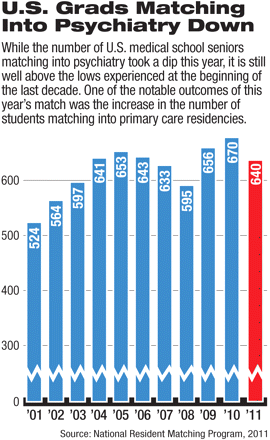A total of 640 U.S. graduating medical students matched into psychiatry training programs in this year's National Resident Matching Program (NRMP), down from last year's figure of 670 who matched into psychiatry.
Those 640 graduates represent 4.1 percent of all U.S. seniors who matched into residency positions this year, falling from 4.5 percent last year. For the past five years, the percentage of graduates matching into psychiatry has remained between 4.1 and 4.6 percent (the percentage was 4.1 in 2008 as well as this year).
A total of 1,069 psychiatry positions were filled this year (out of 1,097 offered). As in past years, positions not filled by U.S. graduating seniors were filled by international medical graduates (including U.S. and non-U.S. citizens), Canadian students, graduates of osteopathic schools, and students who graduated from medical school in previous years.
The match—in which the choices of graduating medical students are "matched" with those of residency programs—is typically watched as an indicator of workforce size and makeup of the various medical specialties for the coming years.
Like last year, one of the notable results of this year's match was the increase in the number of students entering primary care specialties. Of these, family medicine experienced the largest growth, with an 11 percent increase over 2010.
The two other primary care specialties, pediatrics and internal medicine, also increased in popularity. U.S. seniors matched to 1,768 of the 2,482 pediatric positions offered, a 3 percent increase over 2010. In internal medicine, U.S. seniors filled 2,940 of 5,121 positions, an 8 percent increase over last year.
In addition to primary care, other specialties that had a larger number of residency positions filled by U.S. seniors in this year's match included emergency medicine, anesthesiology, and neurology.
While the drop in students entering psychiatry is not dramatic, educators said it is worth attention. "This change is within the variance we have seen for the last six years," said former APA Trustee Sidney Weissman, M.D., a past president of the American Association of Directors of Psychiatric Residency Training, who has maintained a keen interest in workforce issues. "For this reason this change may not have a long-term meaning. However, we must be concerned that it is not the first step in a trend."
He continued, "Senior U.S. medical students select careers for many reasons. We need to assess the factors that today lead to the selection of psychiatric careers. Frequently we hear that students select psychiatric careers because psychiatry offers them an opportunity to become more engaged with their patients. We need to learn more about the coming generation of psychiatrists and their practice desires and those of the current generation of medical students."
Weissman added that it is not yet clear that the jump in primary care matches necessarily represents a dramatic shift away from specialty medicine.
"If you look at the actual numbers of students now going into primary care, the increase is not as great as the hype," he said. "In family medicine, the increase from last year is only 132 students, or less than 1 percent of all senior students. I suspect the increase might include some students who may previously have entered psychiatry, but it mainly relates to the expansion of medical school positions and publicity about the need for primary care."
In a statement following the release of match numbers, J. Fred Ralston Jr., M.D., president of the American College of Physicians, said, "This is good news for internal medicine and adult patient care in the U.S. The American College of Physicians has consistently called for health care reforms that support internal medicine as a career path, including increasing support for primary care training programs, increasing Medicaid and Medicare reimbursement to primary care physicians, and expanding pilot testing and implementation of new models of patient care."
Jerald Kay, M.D., professor and chair of psychiatry at the Boonshoft School of Medicine at Wright State University, suggested that the trend seems to contradict the notion that student indebtedness drives new doctors into more high-paying specialties.
Also, he agreed that the number entering psychiatry is still within the range of the last several years and may not be a cause for immediate concern.
More important for the long-term vitality of the profession, he said, is the overall identity of psychiatry and how it is perceived by students in medical school. He urgently underscored the need to maintain psychotherapy as a core skill of psychiatry.
"At Wright State, we have a very strong psychotherapy program, and a lot of our students are keenly interested in psychotherapy," Kay said. "I have long asserted that it is very shortsighted for the profession to jettison psychotherapy as a core clinical skill. Much of the richness of our field, and its attraction to young medical students, has to do with the ability of psychiatrists to immerse themselves in the lives of their patients."
Kay drew attention to an article that appeared in the New York Times on March 5 under the headline "Talk Doesn't Pay So Psychiatry Turns to Drug Therapy." The article chronicled a senior Pennsylvania psychiatrist who had long practiced psychotherapy but had turned to providing 15-minute med checks because of inadequate insurance reimbursement for psychotherapy.
"We urgently need to pay attention to this and its possible effect on the future students entering our profession," Kay said.

